Abstract
Cellulomonas sp. strain ATCC 21399 is a facultatively anaerobic, cellulose-degrading microorganism that does not evolve hydrogen but produces organic acids during cellulose fermentation. Rhodopseudomonas capsulata cannot utilize cellulose, but grows photoheterotrophically under anaerobic conditions on organic acids or sugars. This report describes an anaerobic coculture of the Cellulomonas strain with wild-type R. capsulata or a mutant strain lacking uptake hydrogenase, which photoevolves molecular hydrogen by the nitrogenase system of R. capsulata with cellulose as the sole carbon source. In coculture, the hydrogenase-negative mutant produced 4.6 to 6.2 mol of H2 per mol of glucose equivalent, compared with 1.2 to 4.3 mol for the wild type.
Full text
PDF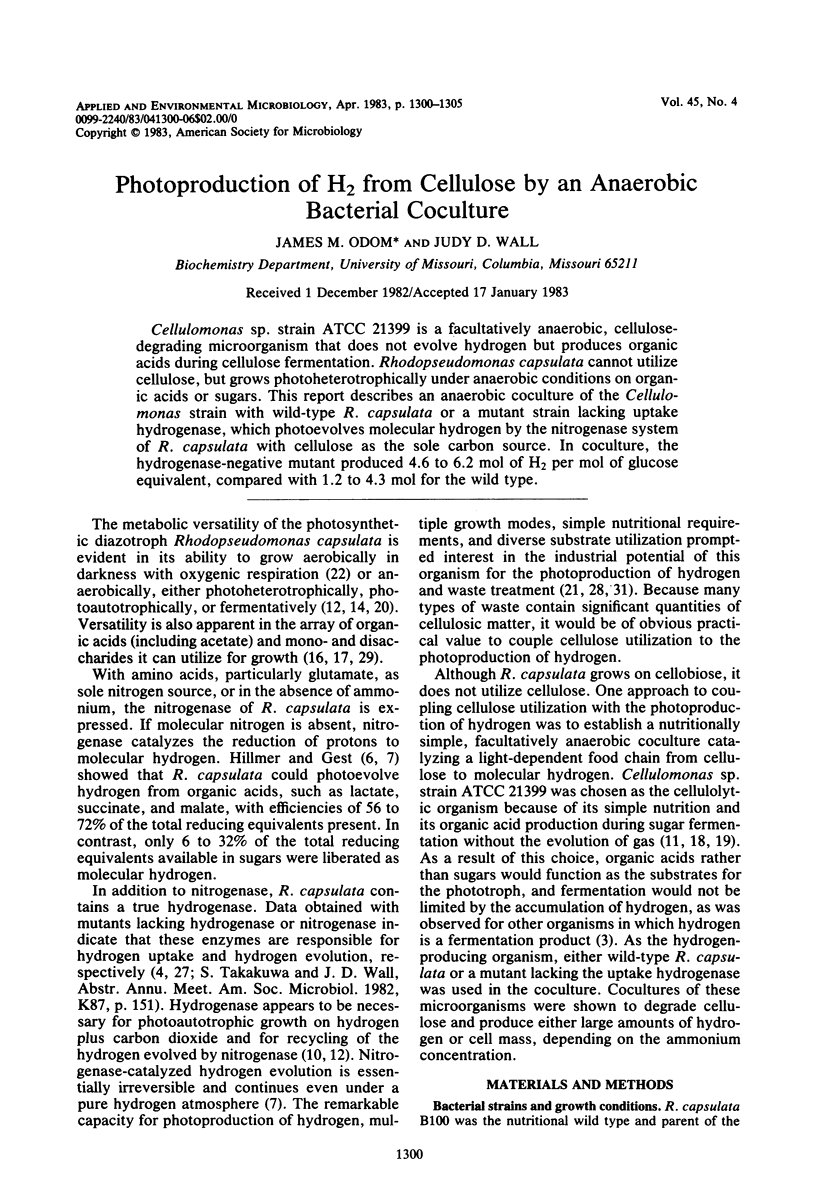
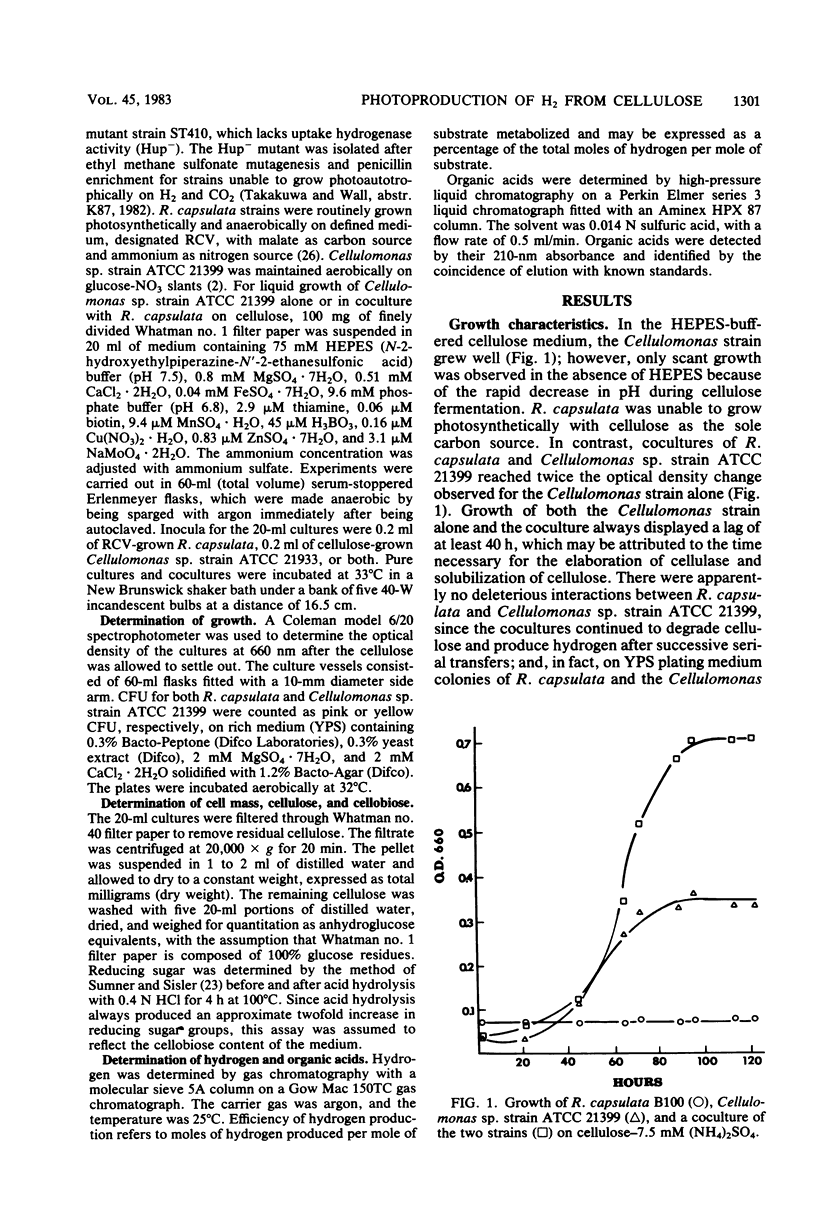
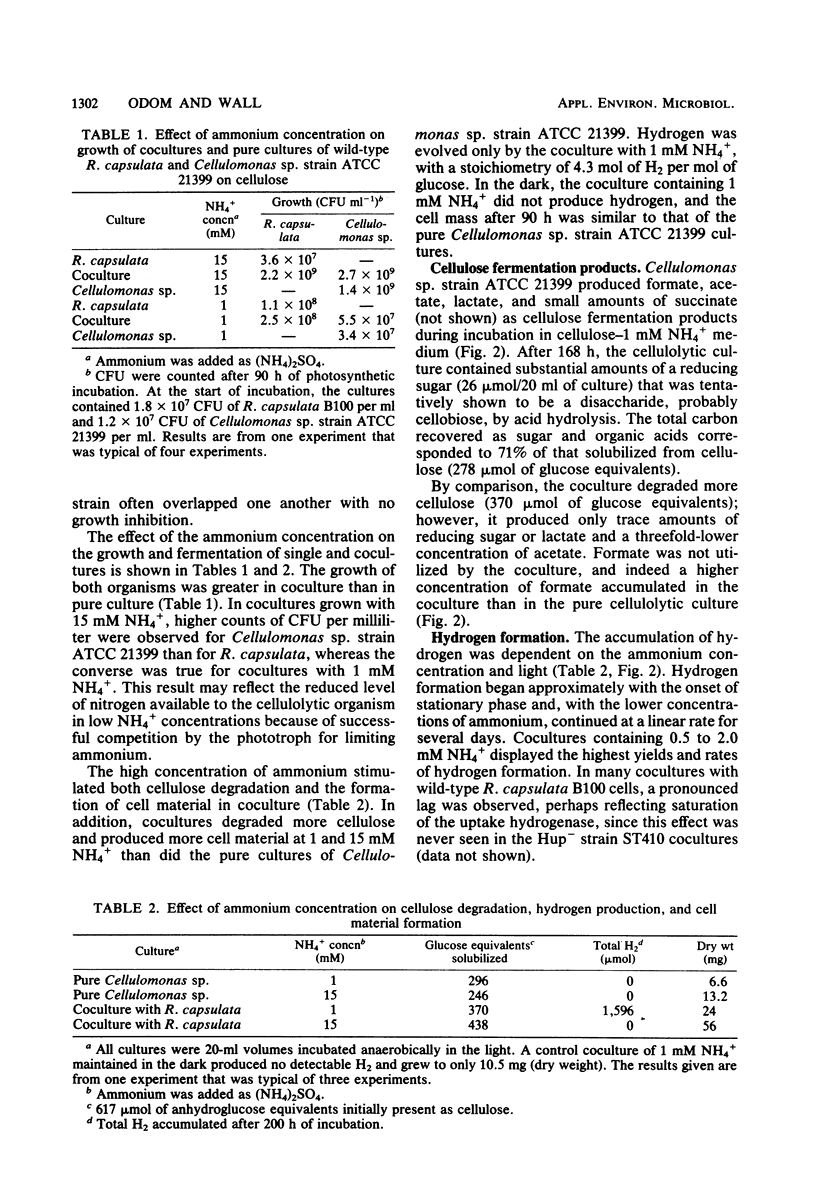
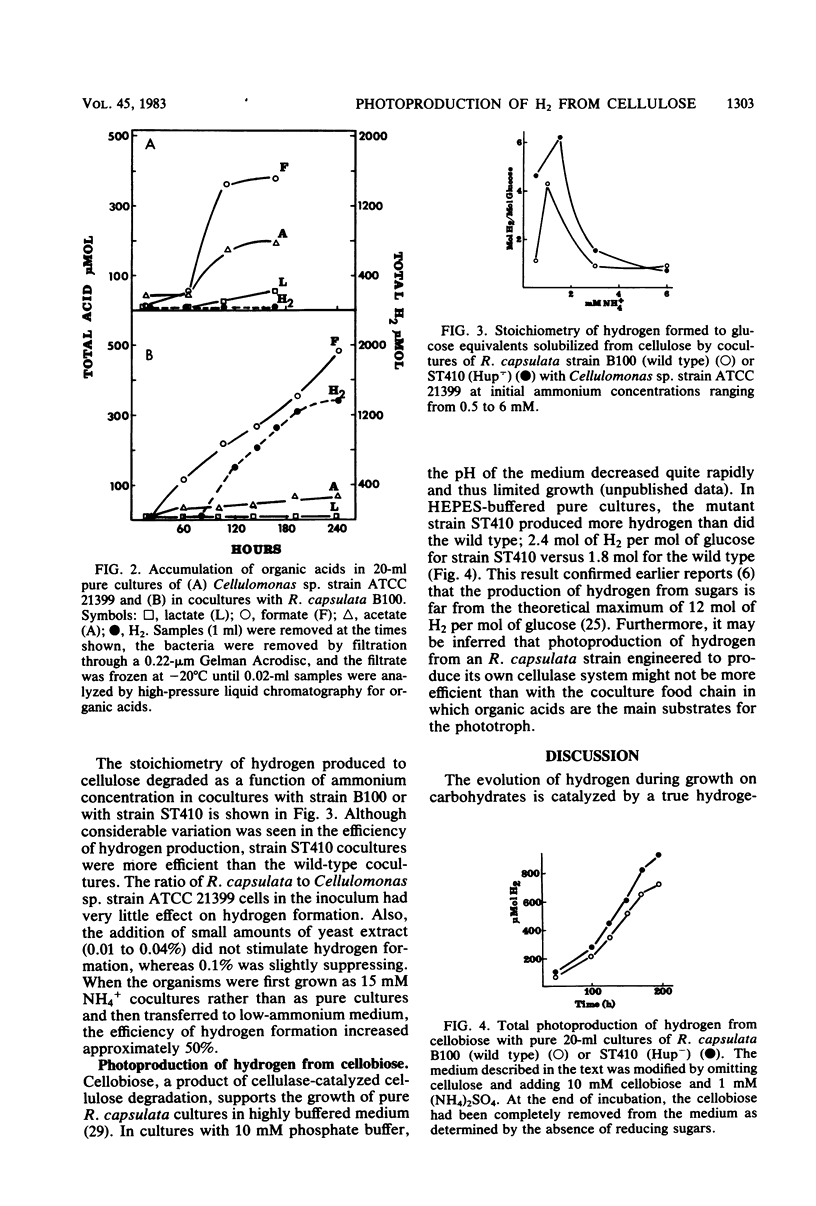
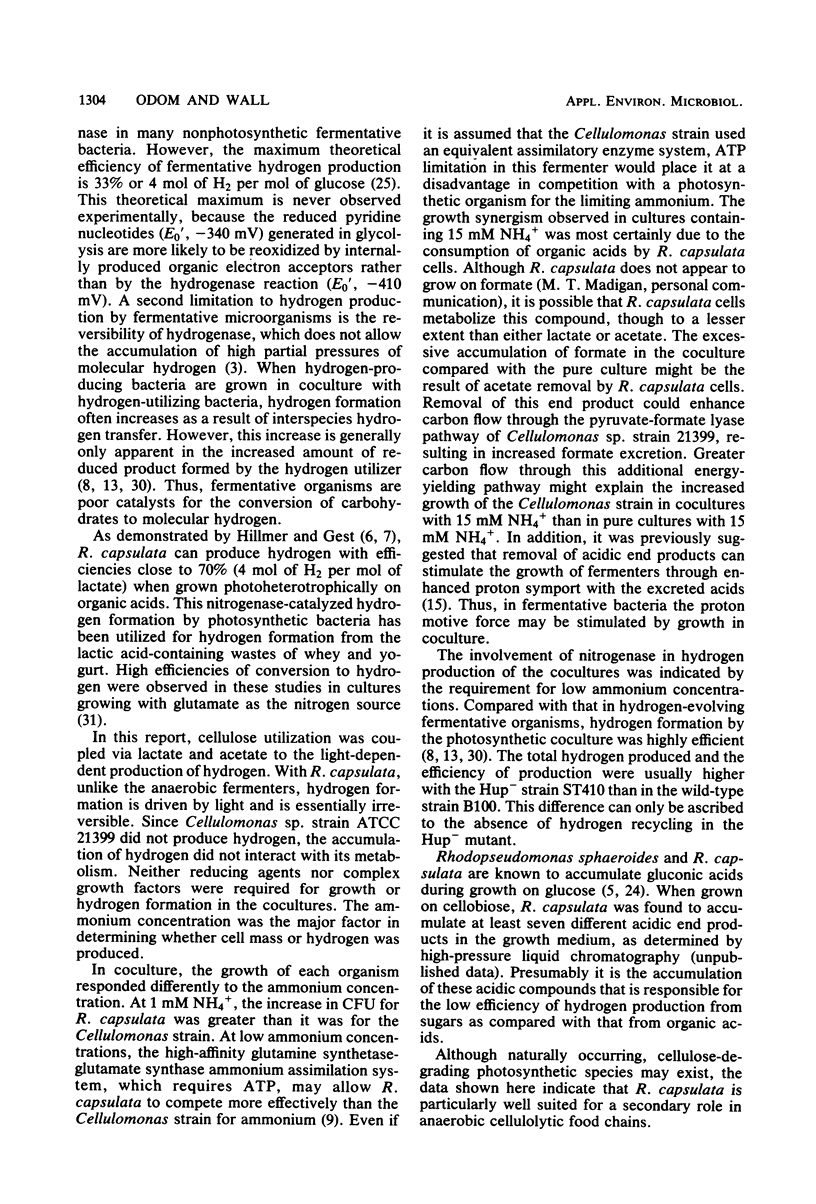
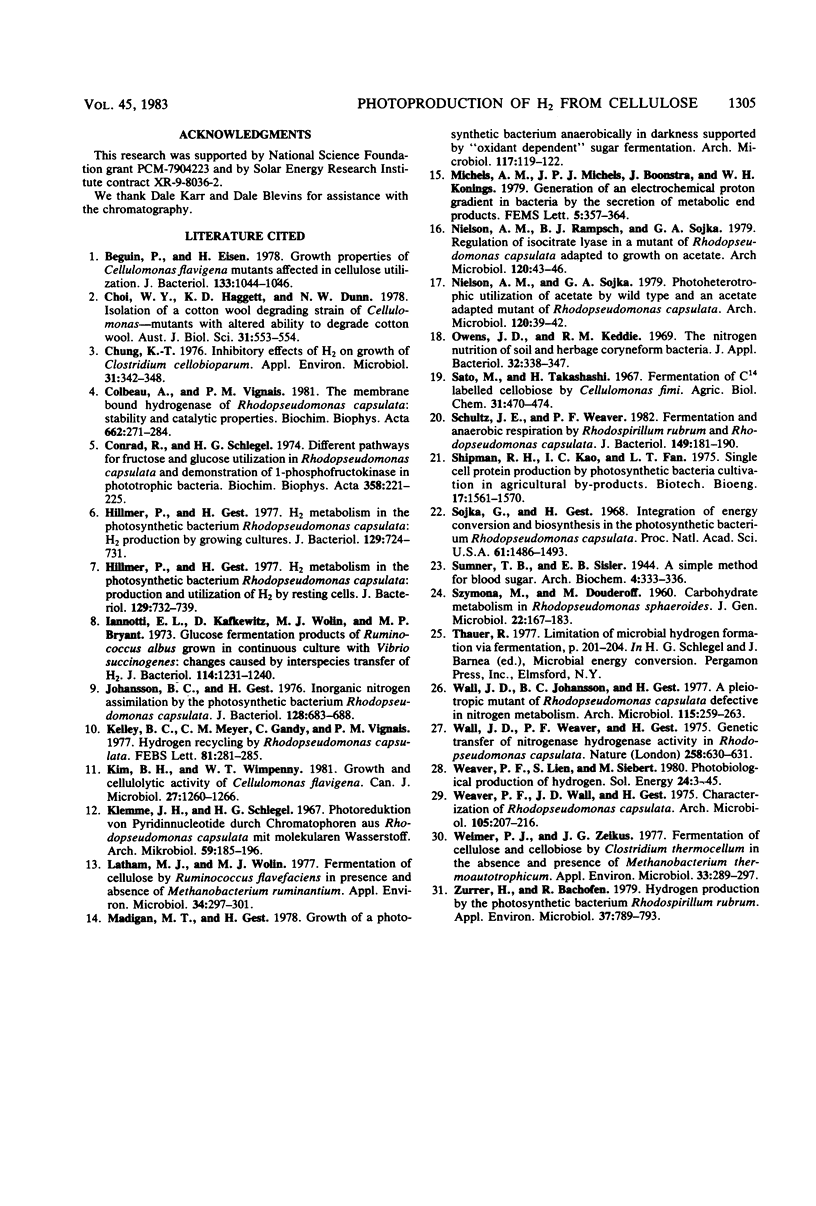
Selected References
These references are in PubMed. This may not be the complete list of references from this article.
- Béguin P., Eisen H. Growth properties of Cellulomonas flavigena mutants affected in cellulose utilization. J Bacteriol. 1978 Feb;133(2):1044–1046. doi: 10.1128/jb.133.2.1044-1046.1978. [DOI] [PMC free article] [PubMed] [Google Scholar]
- Chung K. T. Inhibitory effects of H2 on growth of Clostridium cellobioparum. Appl Environ Microbiol. 1976 Mar;31(3):342–348. doi: 10.1128/aem.31.3.342-348.1976. [DOI] [PMC free article] [PubMed] [Google Scholar]
- Conrad R., Schlegel H. G. Different pathways for fructose and glucose utilization in Rhodopseudomonas capsulata and demonstration of 1-phosphofructokinase in phototrophic bacteria. Biochim Biophys Acta. 1974 Jul 17;358(1):221–225. doi: 10.1016/0005-2744(74)90273-3. [DOI] [PubMed] [Google Scholar]
- Hillmer P., Gest H. H2 metabolism in the photosynthetic bacterium Rhodopseudomonas capsulata: H2 production by growing cultures. J Bacteriol. 1977 Feb;129(2):724–731. doi: 10.1128/jb.129.2.724-731.1977. [DOI] [PMC free article] [PubMed] [Google Scholar]
- Hillmer P., Gest H. H2 metabolism in the photosynthetic bacterium Rhodopseudomonas capsulata: production and utilization of H2 by resting cells. J Bacteriol. 1977 Feb;129(2):732–739. doi: 10.1128/jb.129.2.732-739.1977. [DOI] [PMC free article] [PubMed] [Google Scholar]
- Iannotti E. L., Kafkewitz D., Wolin M. J., Bryant M. P. Glucose fermentation products in Ruminococcus albus grown in continuous culture with Vibrio succinogenes: changes caused by interspecies transfer of H 2 . J Bacteriol. 1973 Jun;114(3):1231–1240. doi: 10.1128/jb.114.3.1231-1240.1973. [DOI] [PMC free article] [PubMed] [Google Scholar]
- Johansson B. C., Gest H. Inorganic nitrogen assimilation by the photosynthetic bacterium Rhodopseudomonas capsulata. J Bacteriol. 1976 Nov;128(2):683–688. doi: 10.1128/jb.128.2.683-688.1976. [DOI] [PMC free article] [PubMed] [Google Scholar]
- Kelley B. C., Meyer C. M., Gandy C., Vignais P. M. Hydrogen recycling by Rhodopseudomonas capsulata. FEBS Lett. 1977 Sep 15;81(2):281–285. doi: 10.1016/0014-5793(77)80535-8. [DOI] [PubMed] [Google Scholar]
- Klemme J. H., Schlegel H. G. Photoreduktion von Pyridinnucleotid durch Chromatophoren aus Rhodopseudomonas capsulata mit molekularem Wasserstoff. Arch Mikrobiol. 1967;59(1):185–196. [PubMed] [Google Scholar]
- Latham M. J., Wolin M. J. Fermentation of cellulose by Ruminococcus flavefaciens in the presence and absence of Methanobacterium ruminantium. Appl Environ Microbiol. 1977 Sep;34(3):297–301. doi: 10.1128/aem.34.3.297-301.1977. [DOI] [PMC free article] [PubMed] [Google Scholar]
- Madigan M. T., Gest H. Growth of a photosynthetic bacterium anaerobically in darkness, supported by "oxidant-dependent" sugar fermentation. Arch Microbiol. 1978 May 30;117(2):119–122. doi: 10.1007/BF00402298. [DOI] [PubMed] [Google Scholar]
- Owens J. D., Keddie R. M. The nitrogen nutrition of soil and herbage coryneform bacteria. J Appl Bacteriol. 1969 Sep;32(3):338–347. doi: 10.1111/j.1365-2672.1969.tb00981.x. [DOI] [PubMed] [Google Scholar]
- SZYMONA M., DOUDOROFF M. Carbohydrate metabolism in Rhodopseudomonas sphreoides. J Gen Microbiol. 1960 Feb;22:167–183. doi: 10.1099/00221287-22-1-167. [DOI] [PubMed] [Google Scholar]
- Schultz J. E., Weaver P. F. Fermentation and anaerobic respiration by Rhodospirillum rubrum and Rhodopseudomonas capsulata. J Bacteriol. 1982 Jan;149(1):181–190. doi: 10.1128/jb.149.1.181-190.1982. [DOI] [PMC free article] [PubMed] [Google Scholar]
- Sojka G. A., Gest H. Integration of energy conversion and biosynthesis in the photosynthetic bacterium Rhodopseudomonas capsulata. Proc Natl Acad Sci U S A. 1968 Dec;61(4):1486–1493. doi: 10.1073/pnas.61.4.1486. [DOI] [PMC free article] [PubMed] [Google Scholar]
- Wall J. D., Johansson B. C., Gest H. A pleiotropic mutant of Rhodopseudomonas capsulata defective in nitrogen metabolism. Arch Microbiol. 1977 Dec 15;115(3):259–263. doi: 10.1007/BF00446450. [DOI] [PubMed] [Google Scholar]
- Wall J. D., Weaver P. F., Gest H. Genetic transfer of nitrogenase-hydrogenase activity in Rhodopseudomonas capsulata. Nature. 1975 Dec 18;258(5536):630–631. doi: 10.1038/258630a0. [DOI] [PubMed] [Google Scholar]
- Weaver P. F., Wall J. D., Gest H. Characterization of Rhodopseudomonas capsulata. Arch Microbiol. 1975 Nov 7;105(3):207–216. doi: 10.1007/BF00447139. [DOI] [PubMed] [Google Scholar]
- Weimer P. J., Zeikus J. G. Fermentation of cellulose and cellobiose by Clostridium thermocellum in the absence of Methanobacterium thermoautotrophicum. Appl Environ Microbiol. 1977 Feb;33(2):289–297. doi: 10.1128/aem.33.2.289-297.1977. [DOI] [PMC free article] [PubMed] [Google Scholar]
- Zürrer H., Bachofen R. Hydrogen Production by the Photosynthetic Bacterium Rhodospirillum rubrum. Appl Environ Microbiol. 1979 May;37(5):789–793. doi: 10.1128/aem.37.5.789-793.1979. [DOI] [PMC free article] [PubMed] [Google Scholar]


